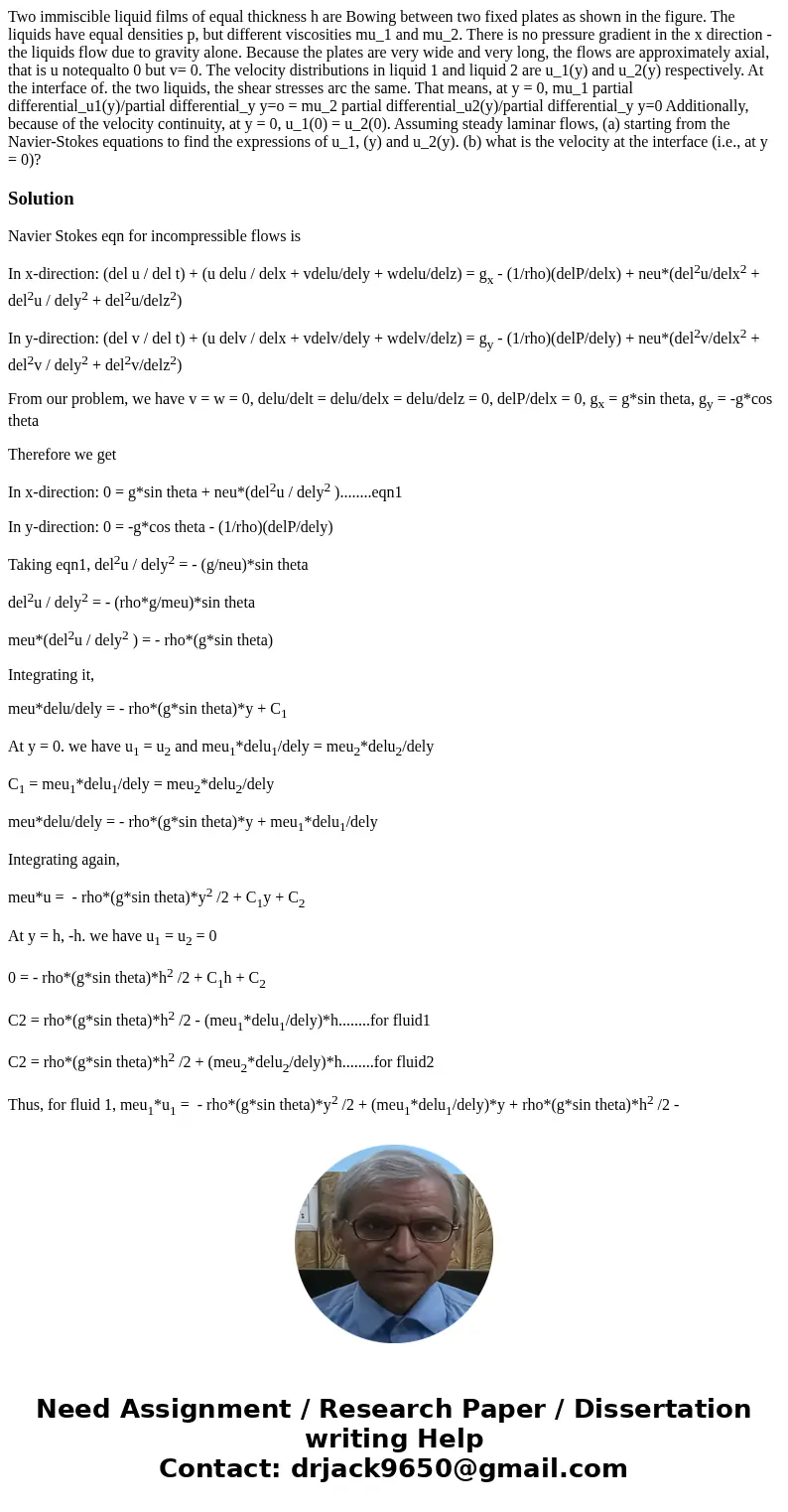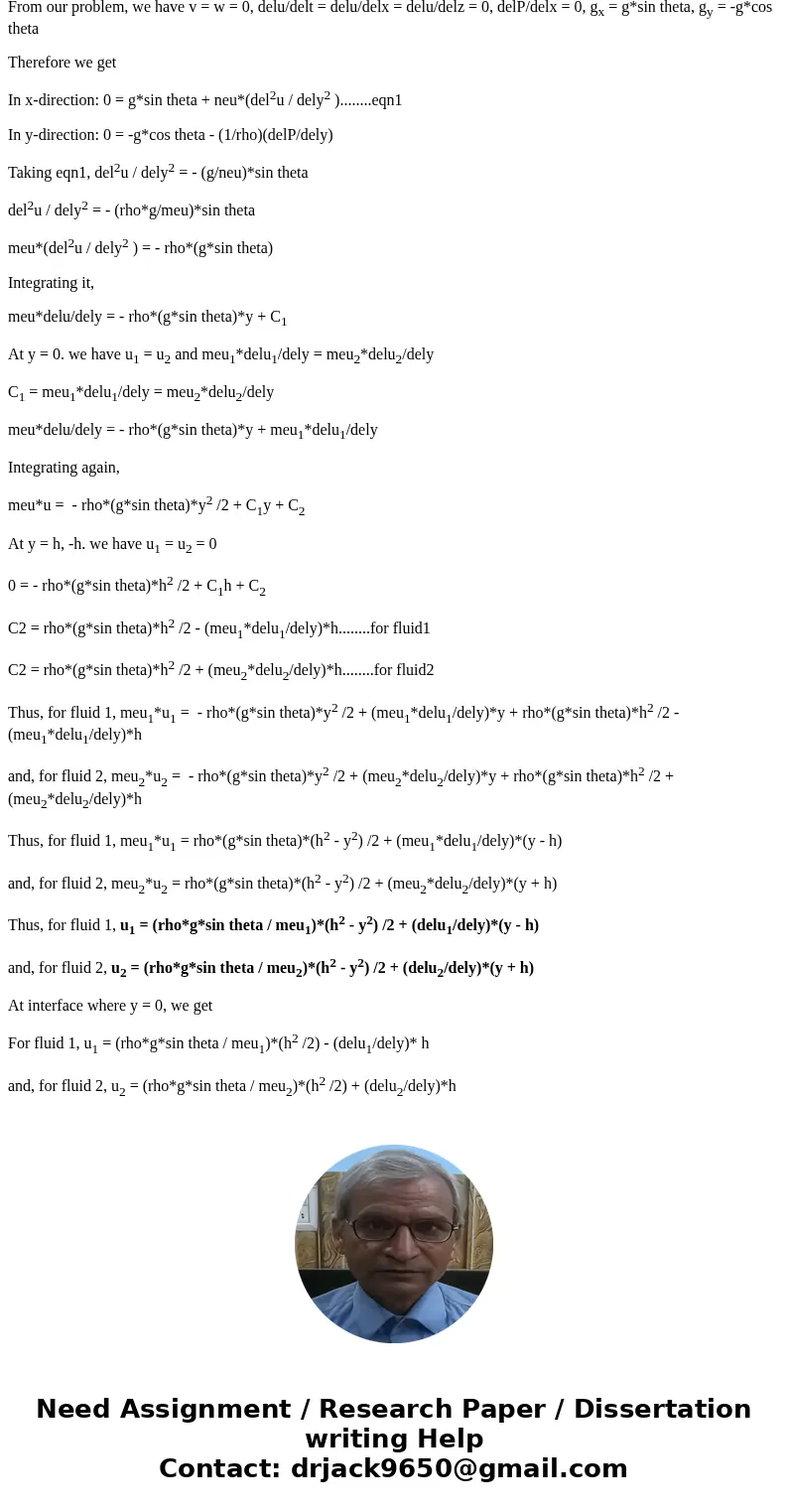Two immiscible liquid films of equal thickness h are Bowing
Solution
Navier Stokes eqn for incompressible flows is
In x-direction: (del u / del t) + (u delu / delx + vdelu/dely + wdelu/delz) = gx - (1/rho)(delP/delx) + neu*(del2u/delx2 + del2u / dely2 + del2u/delz2)
In y-direction: (del v / del t) + (u delv / delx + vdelv/dely + wdelv/delz) = gy - (1/rho)(delP/dely) + neu*(del2v/delx2 + del2v / dely2 + del2v/delz2)
From our problem, we have v = w = 0, delu/delt = delu/delx = delu/delz = 0, delP/delx = 0, gx = g*sin theta, gy = -g*cos theta
Therefore we get
In x-direction: 0 = g*sin theta + neu*(del2u / dely2 )........eqn1
In y-direction: 0 = -g*cos theta - (1/rho)(delP/dely)
Taking eqn1, del2u / dely2 = - (g/neu)*sin theta
del2u / dely2 = - (rho*g/meu)*sin theta
meu*(del2u / dely2 ) = - rho*(g*sin theta)
Integrating it,
meu*delu/dely = - rho*(g*sin theta)*y + C1
At y = 0. we have u1 = u2 and meu1*delu1/dely = meu2*delu2/dely
C1 = meu1*delu1/dely = meu2*delu2/dely
meu*delu/dely = - rho*(g*sin theta)*y + meu1*delu1/dely
Integrating again,
meu*u = - rho*(g*sin theta)*y2 /2 + C1y + C2
At y = h, -h. we have u1 = u2 = 0
0 = - rho*(g*sin theta)*h2 /2 + C1h + C2
C2 = rho*(g*sin theta)*h2 /2 - (meu1*delu1/dely)*h........for fluid1
C2 = rho*(g*sin theta)*h2 /2 + (meu2*delu2/dely)*h........for fluid2
Thus, for fluid 1, meu1*u1 = - rho*(g*sin theta)*y2 /2 + (meu1*delu1/dely)*y + rho*(g*sin theta)*h2 /2 - (meu1*delu1/dely)*h
and, for fluid 2, meu2*u2 = - rho*(g*sin theta)*y2 /2 + (meu2*delu2/dely)*y + rho*(g*sin theta)*h2 /2 + (meu2*delu2/dely)*h
Thus, for fluid 1, meu1*u1 = rho*(g*sin theta)*(h2 - y2) /2 + (meu1*delu1/dely)*(y - h)
and, for fluid 2, meu2*u2 = rho*(g*sin theta)*(h2 - y2) /2 + (meu2*delu2/dely)*(y + h)
Thus, for fluid 1, u1 = (rho*g*sin theta / meu1)*(h2 - y2) /2 + (delu1/dely)*(y - h)
and, for fluid 2, u2 = (rho*g*sin theta / meu2)*(h2 - y2) /2 + (delu2/dely)*(y + h)
At interface where y = 0, we get
For fluid 1, u1 = (rho*g*sin theta / meu1)*(h2 /2) - (delu1/dely)* h
and, for fluid 2, u2 = (rho*g*sin theta / meu2)*(h2 /2) + (delu2/dely)*h


 Homework Sourse
Homework Sourse